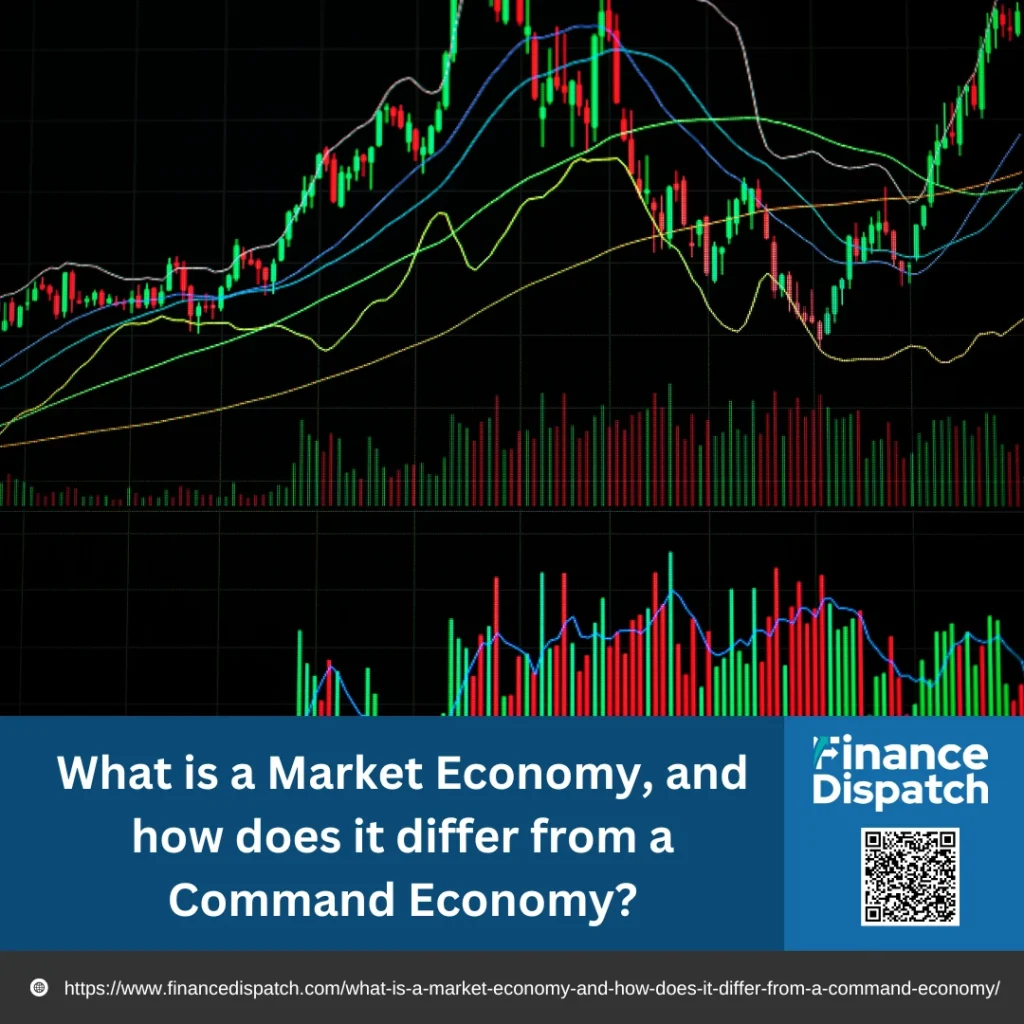Every nation operates within an economic system that dictates how goods and services are produced, distributed, and consumed. Among the various economic models, the market economy and command economy represent two contrasting approaches to resource allocation and decision-making. In a market economy, businesses and individuals determine production and pricing based on supply and demand, fostering competition and innovation. Conversely, a command economy is centrally planned, where the government controls industries, sets prices, and dictates production to meet collective goals. While each system has its strengths and weaknesses, understanding their differences is crucial in evaluating how economies function and impact society. This article explores the characteristics, advantages, and disadvantages of both systems and examines why most modern economies adopt a blend of both approaches.
What is a Market Economy?
A market economy is an economic system in which the production and distribution of goods and services are driven by the forces of supply and demand, with minimal government intervention. In this system, private individuals and businesses own resources and make economic decisions based on consumer preferences, competition, and profit motives. Prices fluctuate naturally as buyers and sellers negotiate exchanges in a free market, ensuring that goods and services are produced efficiently and meet demand. Market economies are often associated with capitalism, as they encourage entrepreneurship, innovation, and economic growth. While most modern economies incorporate some level of government regulation to prevent market failures, the defining characteristic of a market economy remains decentralized decision-making, where businesses and consumers shape economic outcomes through voluntary transactions. Countries like the United States, Japan, and Germany operate primarily under market-based principles, though they still incorporate government oversight to address economic and social concerns.
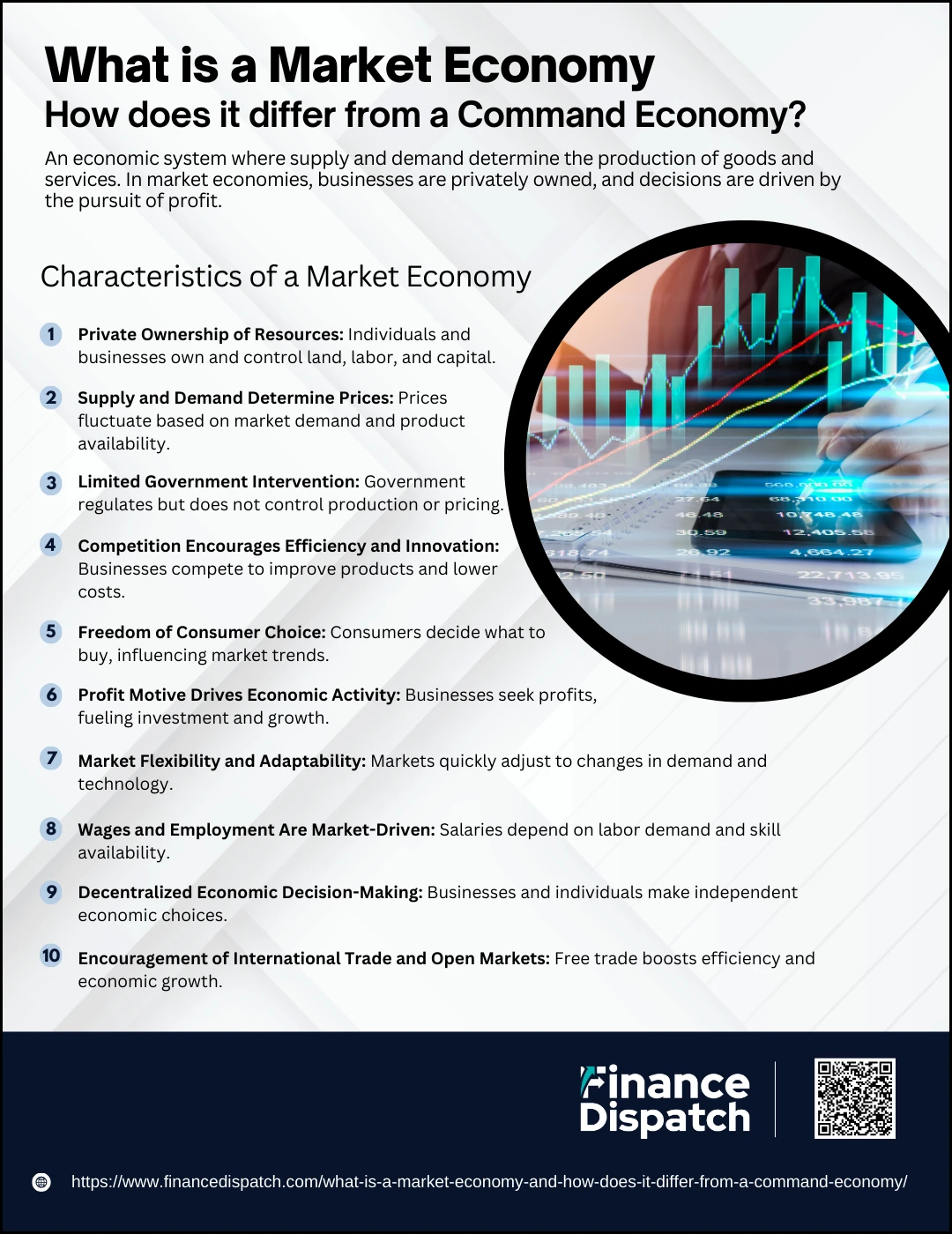 Characteristics of a Market Economy
Characteristics of a Market Economy
A market economy is an economic system where businesses and individuals make production, pricing, and investment decisions based on supply and demand, rather than direct government control. This system is driven by competition, consumer preferences, and the profit motive, leading to innovation and efficiency. Unlike command economies, where the government dictates economic activities, market economies allow for private ownership and decentralized decision-making. While some regulations exist to ensure fairness and prevent market failures, market economies largely operate on free-market principles, where businesses compete to offer better products and services at competitive prices. Below are the key characteristics that define a market economy and contribute to its functionality.
Key Characteristics of a Market Economy
1. Private Ownership of Resources
Individuals and businesses own and control resources, including land, labor, and capital. The government does not directly manage production or industry, except in cases of necessary regulation or public goods.
2. Supply and Demand Determine Prices
Prices fluctuate naturally based on consumer demand and product availability. When demand is high and supply is low, prices increase; when supply exceeds demand, prices drop. This creates a self-regulating market where goods and services adjust based on consumer needs.
3. Limited Government Intervention
Governments mainly act as regulators rather than direct participants. They establish laws to protect property rights, prevent monopolies, and enforce contracts but do not directly control production or pricing.
4. Competition Encourages Efficiency and Innovation
Businesses compete to offer better quality products at lower prices, leading to technological advancements and improved efficiency in production. This benefits consumers by increasing choices and affordability.
5. Freedom of Consumer Choice
Consumers can decide what to buy, from whom, and at what price. This power of choice influences businesses to continuously improve their offerings to remain competitive in the market.
6. Profit Motive Drives Economic Activity
Entrepreneurs and businesses seek to maximize profits, which encourages investment, business expansion, and economic growth. High-performing businesses thrive, while inefficient ones either improve or exit the market.
7. Market Flexibility and Adaptability
Market economies quickly adjust to changes in consumer preferences, technological advancements, and global economic conditions. This allows businesses to innovate and restructure operations as needed.
8. Wages and Employment Are Market-Driven
Employers set wages based on the demand for labor and the availability of skilled workers. High-demand professions command higher salaries, while low-demand jobs may see wage stagnation.
9. Decentralized Economic Decision-Making
Instead of government planning, millions of individuals and businesses make independent decisions about what to produce, sell, or buy, creating an organic and self-sustaining economy.
10. Encouragement of International Trade and Open Markets
Market economies support free trade and globalization, allowing countries to specialize in industries where they have a competitive advantage. This increases efficiency, economic growth, and access to a wider range of goods and services.
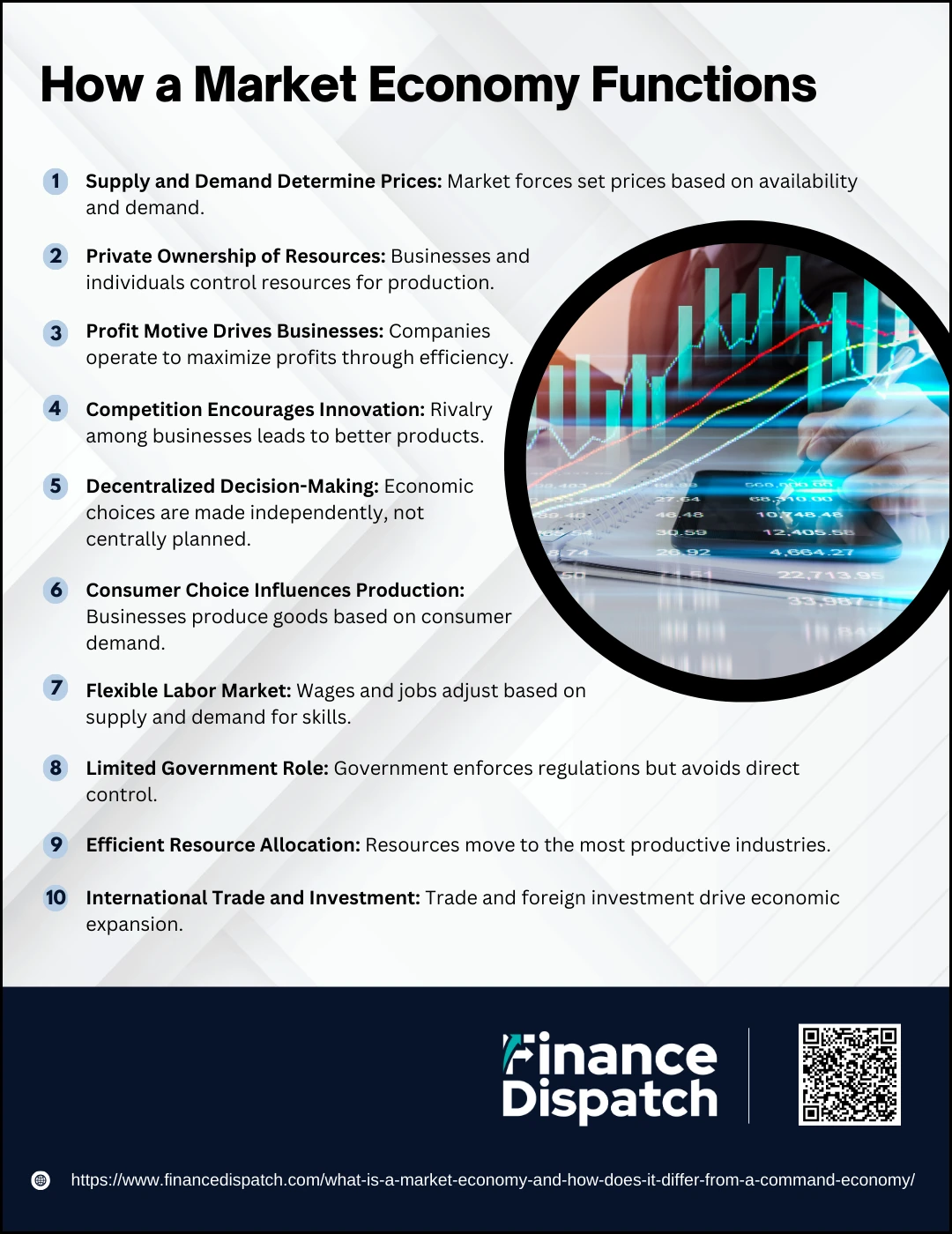 How a Market Economy Functions
How a Market Economy Functions
A market economy operates on the principles of supply and demand, where businesses and individuals make economic decisions without significant government intervention. Prices, production, and distribution of goods and services are determined by competition and consumer preferences. This system encourages innovation, efficiency, and economic growth as businesses strive to meet market demands while maximizing profits. Below are the key processes that define how a market economy functions.
Key Processes in a Market Economy
1. Supply and Demand Determine Prices
Prices of goods and services fluctuate based on consumer demand and the availability of supply, ensuring an efficient allocation of resources.
2. Private Ownership of Resources
Individuals and businesses own and control land, labor, and capital, allowing for entrepreneurship and investment in new ideas.
3. Profit Motive Drives Businesses
Companies seek to maximize profits by offering products and services that consumers value, which encourages efficiency and innovation.
4. Competition Encourages Innovation
Businesses compete to attract customers, leading to improved product quality, technological advancements, and better services.
5. Decentralized Decision-Making
Economic decisions are made by individuals and businesses rather than a central authority, allowing for a flexible and adaptive economy.
6. Consumer Choice Influences Production
Consumers have the freedom to choose what they buy, which signals businesses to produce goods and services that align with market demand.
7. Flexible Labor Market
Wages and employment opportunities are determined by market forces, with workers choosing jobs based on salaries and working conditions.
8. Limited Government Role
The government primarily regulates markets to ensure fair competition, protect property rights, and enforce contracts rather than controlling production.
9. Efficient Resource Allocation
Resources naturally flow toward the most productive and profitable industries, reducing waste and maximizing economic output.
10. International Trade and Investment
Market economies encourage trade with other countries, allowing businesses to expand, access raw materials, and increase economic opportunities.
Advantages and Disadvantages of a Market Economy
A market economy is a system where economic activities are guided by the principles of supply and demand, with minimal government intervention. This system promotes competition, innovation, and economic efficiency, allowing businesses and individuals to make independent financial decisions. However, while a market economy offers several benefits, it also comes with challenges such as inequality and market instability. Below are the key advantages and disadvantages of a market economy.
Advantages of a Market Economy
- Encourages Innovation and Efficiency – Businesses constantly strive to improve products and services to stay competitive, leading to technological advancements and better quality.
- Consumer Choice and Variety – Consumers have access to a wide range of products and services, as businesses compete to meet diverse demands.
- Higher Economic Growth – Free markets promote investment, entrepreneurship, and wealth creation, leading to economic expansion.
- Efficient Resource Allocation – Market forces naturally direct resources to industries where they are most needed, reducing waste and maximizing productivity.
- Flexibility and Adaptability – Market economies can quickly adjust to changes in consumer preferences, technology, and global economic conditions.
- Profit Motive Drives Productivity – The pursuit of profit encourages businesses to be efficient and cost-effective, leading to economic development.
- Less Bureaucracy and Government Oversight – With minimal government intervention, businesses can operate with fewer restrictions, leading to faster decision-making and economic dynamism.
Disadvantages of a Market Economy
- Income Inequality – Wealth is often concentrated among a small portion of the population, leading to economic disparities.
- Market Failures – Without government regulation, negative externalities like pollution, monopolies, and financial crises can emerge.
- Unemployment and Job Insecurity – Economic downturns and automation can lead to job losses, as businesses prioritize cost-cutting measures.
- Public Goods and Services May Be Neglected – Essential services like healthcare, education, and infrastructure may not be adequately provided if they are not profitable.
- Risk of Exploitation – Businesses may exploit workers, charge high prices, or compromise on product quality in pursuit of profit.
- Economic Instability – Market economies are prone to cycles of booms and recessions, which can lead to financial uncertainty.
What is a Command Economy?
A command economy is an economic system in which the government has complete control over the production, distribution, and pricing of goods and services. Instead of supply and demand dictating market activities, a central authority makes all economic decisions, determining what to produce, how much to produce, and at what price. This system aims to ensure economic stability, social welfare, and equal distribution of resources, often prioritizing national goals over individual profits. Command economies are commonly associated with socialist or communist ideologies, where industries, land, and resources are state-owned. While this model can effectively mobilize resources for large-scale projects and provide basic necessities to all citizens, it often lacks efficiency, competition, and innovation, leading to shortages, bureaucracy, and slower economic growth. Countries such as North Korea and Cuba still operate under a command economy, while others, like China and Russia, have transitioned to mixed economies that incorporate market-driven elements.
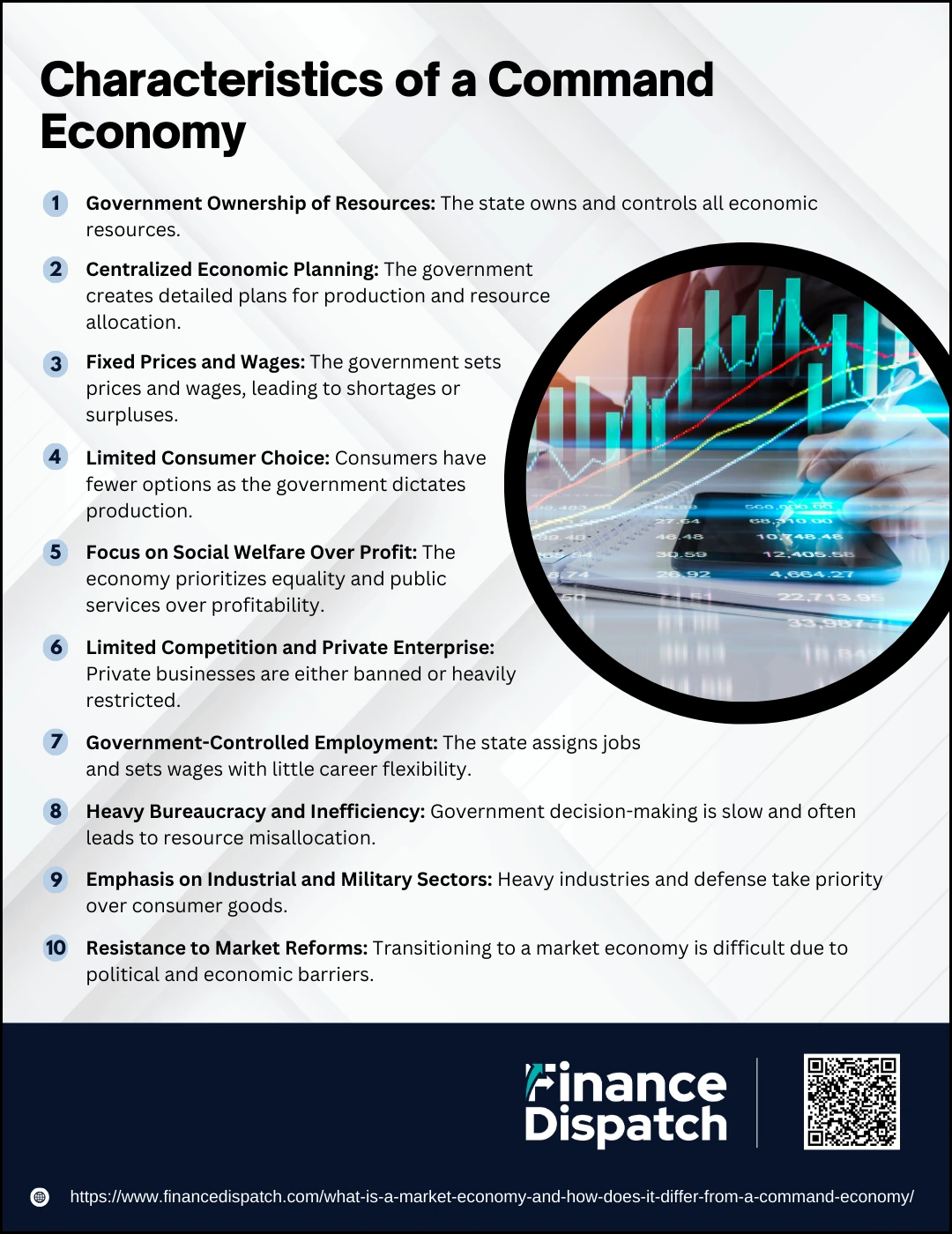 Characteristics of a Command Economy
Characteristics of a Command Economy
A command economy is an economic system where the government has complete control over production, resource allocation, and pricing. Unlike a market economy, where supply and demand dictate economic decisions, a command economy relies on centralized planning to determine what goods and services are produced, in what quantity, and at what price. This system is often implemented in socialist or communist states to ensure economic stability, equal wealth distribution, and national development goals. However, command economies tend to suffer from inefficiency, lack of innovation, and limited consumer choices due to excessive government control. Below are the key characteristics that define a command economy.
Key Characteristics of a Command Economy
1. Government Ownership of Resources
In a command economy, the government owns and controls all key economic resources, including land, factories, and natural resources. Unlike in a market economy, where individuals and businesses own assets, the state dictates how resources are utilized to meet national priorities.
2. Centralized Economic Planning
The government creates detailed plans—often in the form of multi-year strategies—that dictate economic production, investment, and resource allocation. These plans determine what goods and services should be produced, the amount to be produced, and how they should be distributed.
3. Fixed Prices and Wages
Instead of allowing supply and demand to set prices, the government artificially determines the prices of goods and services, as well as wages for workers. While this can prevent extreme price fluctuations, it often leads to shortages or surpluses.
4. Limited Consumer Choice
Because the government dictates production, consumers have fewer options when purchasing goods and services. Unlike in a market economy, where businesses compete to meet consumer preferences, command economies produce what the state deems necessary, often ignoring consumer demand.
5. Focus on Social Welfare Over Profit
The primary goal of a command economy is to reduce economic inequality and ensure social welfare. The government prioritizes essential services like healthcare, education, and infrastructure, often at the cost of efficiency and economic growth.
6. Limited Competition and Private Enterprise
There is little to no private enterprise in a command economy, as businesses are state-controlled. Without competition, companies lack incentives to innovate or improve efficiency, leading to outdated technology and lower productivity.
7. Government-Controlled Employment
The government assigns jobs to individuals based on national labor needs. This ensures low unemployment but also limits career mobility and wage growth, as salaries and promotions are often standardized.
8. Heavy Bureaucracy and Inefficiency
Decision-making in command economies is highly bureaucratic. Policies and economic changes require approval from multiple layers of government, leading to slow adaptation to economic challenges and inefficiencies in resource distribution.
9. Emphasis on Industrial and Military Sectors
Many command economies focus on heavy industries, infrastructure, and military development, often at the expense of consumer goods and services. This prioritization can lead to shortages of everyday products needed by the public.
10. Resistance to Market Reforms
Since the government controls all aspects of the economy, transitioning to a market-based system can be difficult. Political resistance and economic instability often arise when reforms are introduced, as seen in historical cases like the Soviet Union’s shift toward a mixed economy.
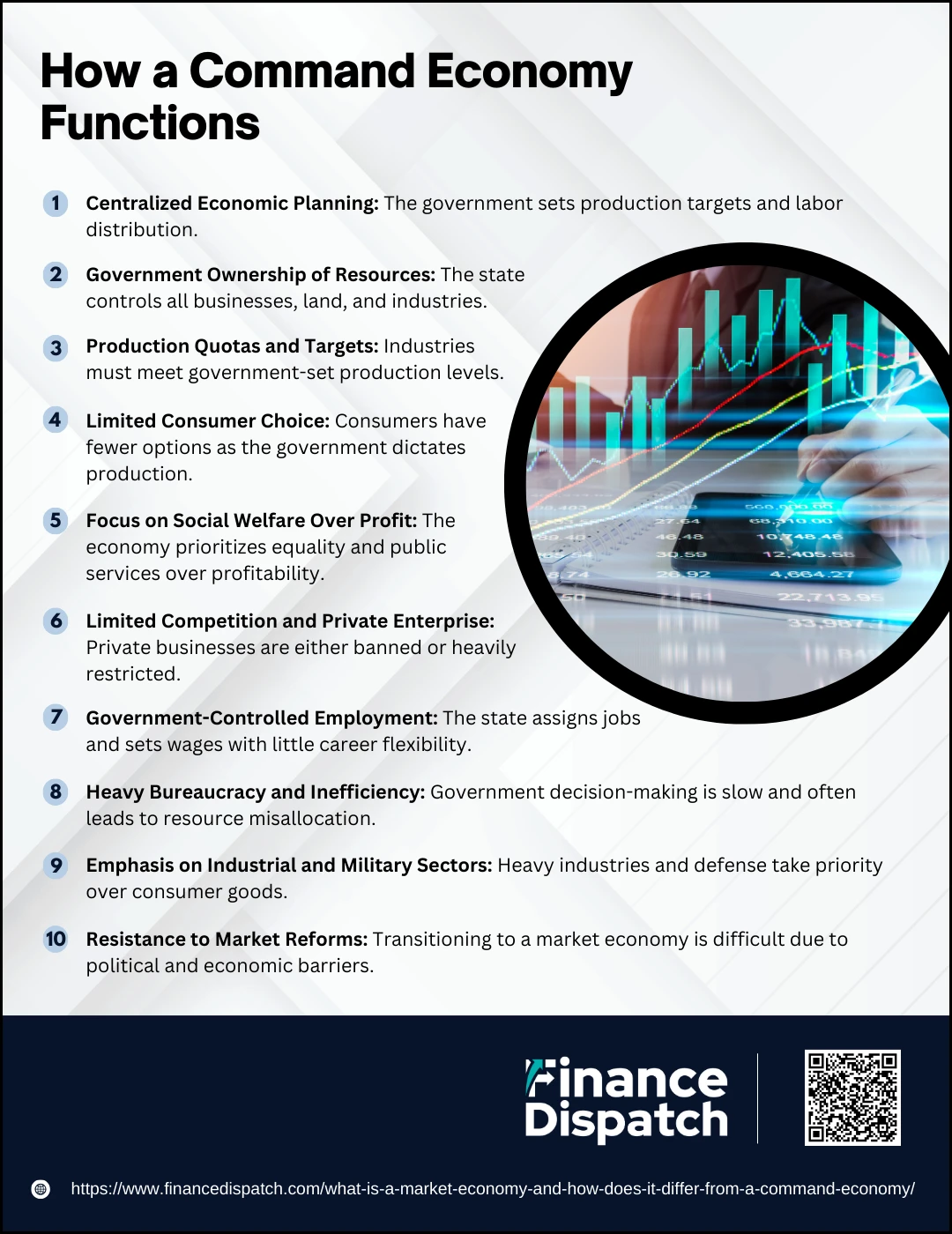 How a Command Economy Functions
How a Command Economy Functions
A command economy is an economic system in which the government has full control over production, pricing, and resource allocation. Unlike a market economy, where supply and demand dictate economic activities, a command economy operates through centralized planning, where a governing authority decides what goods and services should be produced, in what quantity, and at what price. The primary goal of this system is to ensure economic stability, social equality, and national development by eliminating competition and wealth disparities. However, this centralized control often results in inefficiencies, lack of innovation, and limited consumer choices. Below are the key processes that explain how a command economy functions.
Key Processes in a Command Economy
1. Centralized Economic Planning
The government develops detailed economic plans—often in the form of five-year strategies—that outline production targets, labor distribution, and resource allocation for industries. These plans serve as a blueprint for the entire economy.
2. Government Ownership of Resources
All land, factories, businesses, and natural resources are owned and managed by the government. Unlike in a market economy, where private individuals control resources, the state decides how to utilize them to achieve national priorities.
3. Production Quotas and Targets
The government assigns specific production quotas to industries and businesses based on national needs rather than consumer demand. Factories and farms must meet these quotas, which can sometimes lead to overproduction or shortages.
4. Fixed Pricing System
Prices of goods and services are set by the government rather than being determined by supply and demand. This ensures affordability but often results in artificial shortages or surpluses since pricing does not reflect market conditions.
5. State-Controlled Employment and Wages
The government assigns jobs to workers based on labor needs and economic goals. Wages are standardized, and individuals have limited ability to change jobs or negotiate higher salaries, reducing motivation and productivity.
6. Restricted Private Enterprise
Private businesses are either nonexistent or heavily regulated. Instead of allowing entrepreneurship and competition, the government controls all industries, making it difficult for individuals to start their own businesses.
7. Emphasis on Social Welfare and Equality
Command economies focus on providing essential public services such as free healthcare, education, and housing to reduce income inequality. However, these services can suffer from inefficiencies due to a lack of market competition.
8. Government Regulation of Imports and Exports
The government controls international trade by deciding what goods can be imported or exported. This is done to protect domestic industries and maintain economic self-sufficiency, often resulting in limited access to foreign goods.
9. Limited Consumer Choice
Since production is planned by the state, consumers have fewer choices when purchasing goods and services. Unlike in a market economy, where businesses compete to meet consumer preferences, command economies focus on fulfilling government priorities.
10. Slow Response to Economic Changes
The heavy bureaucracy in command economies makes it difficult to adapt to changing economic conditions. Unlike market economies, where businesses quickly adjust production based on demand, command economies are rigid and slow to reform, often leading to economic stagnation.
Advantages and Disadvantages of a Command Economy
A command economy is a system where the government controls all aspects of economic activity, including production, distribution, and pricing. Unlike a market economy, where supply and demand dictate business decisions, a command economy relies on centralized planning to allocate resources and ensure economic stability. This system aims to reduce income inequality, provide essential public services, and maintain full employment. However, while a command economy offers certain benefits such as stability and social welfare, it also comes with challenges, including inefficiency, lack of innovation, and limited consumer choices. Below are the key advantages and disadvantages of a command economy.
Advantages of a Command Economy
- Economic Stability – Government control prevents market fluctuations, reducing the risks of inflation, unemployment, and financial crises.
- Equal Wealth Distribution – The state regulates wages and prices to ensure fair income distribution, reducing economic inequality.
- Full Employment – The government assigns jobs to workers, ensuring that everyone has a role in the economy and unemployment is minimized.
- Access to Essential Services – Public services like healthcare, education, and housing are often provided for free or at low cost, improving overall social welfare.
- Strong National Focus – The government can direct resources toward long-term national goals, such as industrialization, defense, or large infrastructure projects.
- Prevention of Monopolies – Since businesses are state-owned, private monopolies cannot exploit consumers, and economic power remains centralized.
- Control Over Strategic Industries – The government prioritizes key sectors such as energy, healthcare, and transportation to ensure national security and self-sufficiency.
Disadvantages of a Command Economy
- Lack of Innovation – With little competition or profit motive, businesses lack incentives to innovate, leading to outdated technology and stagnation.
- Inefficiency in Resource Allocation – Government planning often results in overproduction or shortages, as production is based on quotas rather than consumer demand.
- Limited Consumer Choice – Citizens have access to only a few government-approved products, reducing variety and quality in the marketplace.
- Bureaucratic Delays – Economic decisions require multiple approvals from government officials, slowing down production and adaptation to changing needs.
- Low Worker Motivation – Since wages and jobs are fixed, employees lack motivation to work harder or improve productivity.
- Black Markets and Corruption – Due to restricted goods and price controls, illegal markets often emerge, leading to corruption and inefficiencies.
- Difficulty in Adapting to Global Changes – Command economies struggle to compete in a globalized world, as their rigid systems cannot quickly adjust to technological advancements or international trade shifts.
Key Differences between a Market and Command Economy
A market economy and a command economy represent two distinct approaches to economic organization, each with its own principles and consequences. In a market economy, businesses and individuals make economic decisions based on supply and demand, leading to competition, innovation, and efficiency. In contrast, a command economy relies on government control, where central planners determine production, pricing, and distribution of goods and services. While market economies promote entrepreneurship and consumer choice, command economies prioritize economic stability and social equality. Below is a table highlighting the key differences between these two systems.
Comparison of Market and Command Economy
| Aspect | Market Economy | Command Economy |
| Ownership of Resources | Private individuals and businesses own land, labor, and capital. | The government owns and controls all economic resources. |
| Decision-Making | Decentralized—businesses and consumers make independent choices. | Centralized—the government determines what, how, and for whom to produce. |
| Price Determination | Prices are set by supply and demand. | The government fixes prices, often leading to shortages or surpluses. |
| Competition | Strong competition drives innovation and efficiency. | No competition—state-run enterprises dominate all industries. |
| Economic Growth | Typically higher due to private investment and market-driven production. | Slower due to bureaucratic inefficiencies and lack of competition. |
| Consumer Choice | Consumers have a wide variety of goods and services to choose from. | Limited product choices as production is based on government plans. |
| Innovation and Technology | Encourages innovation through profit incentives and competition. | Lack of incentives leads to slower technological advancement. |
| Government Role | Limited—government mainly enforces laws and regulates market failures. | Extensive—government controls production, wages, and trade. |
| Income Distribution | Income is based on market performance, often leading to inequality. | Government aims for equal distribution but may lead to inefficiencies. |
| Employment | Jobs are created based on business needs; unemployment can fluctuate. | Government assigns jobs, ensuring full employment but limiting career mobility. |
Real-World Examples of Market and Command Economies
While pure market and command economies are rare, many countries operate predominantly under one system with varying degrees of government involvement. Market economies emphasize private ownership, competition, and consumer choice, while command economies rely on centralized planning and government control. However, most nations today have adopted a mixed economy, incorporating elements of both systems. Below are real-world examples of countries that predominantly follow market or command economy principles.
Examples of Market Economies
- United States – A leading market economy with private ownership, minimal government intervention, and strong competition in various industries.
- United Kingdom – Encourages free-market principles with limited regulation and government intervention in essential services.
- Japan – A highly developed market economy known for technological innovation and competitive industries.
- Germany – A strong market economy with a balance of private enterprise and government regulation to support social welfare.
- Canada – Primarily a market economy with public funding for essential services like healthcare and education.
- Australia – A free-market system with a high degree of consumer choice and private-sector participation.
Examples of Command Economies
- North Korea – One of the most extreme command economies, where the government controls all aspects of production, pricing, and resource allocation.
- Cuba – A socialist economy with heavy state control over industries, although recent reforms have introduced limited private enterprise.
- Soviet Union (Historical Example) – Operated under a fully planned economy with government-controlled industries and production quotas.
- China (Pre-1978) – Before introducing market reforms, China followed a strict command economy model with centralized planning and government ownership.
- Venezuela – While not a fully planned economy, heavy government intervention and nationalization of industries have pushed it towards command economy characteristics.
Which Economic System is Better?
There is no single “best” economic system, as both market and command economies have their strengths and weaknesses, depending on a country’s goals, resources, and societal values. A market economy encourages competition, innovation, and efficiency, leading to higher economic growth and consumer choice. However, it can also result in income inequality, unemployment, and market failures. On the other hand, a command economy ensures economic stability, equal distribution of resources, and full employment, but often lacks efficiency, innovation, and consumer choice due to excessive government control. In reality, most nations today adopt a mixed economic system, combining market-driven mechanisms with government intervention to balance economic growth with social welfare. The ideal system varies based on national priorities—whether they emphasize individual freedoms and entrepreneurship or economic stability and social equity.
Conclusion
Economic systems play a crucial role in shaping a nation’s prosperity, resource allocation, and social structure. While market economies drive innovation, competition, and economic growth, they can also lead to income inequality and market instability. In contrast, command economies prioritize stability, equality, and government control, but often suffer from inefficiency, lack of competition, and limited consumer choice. In reality, no economy is purely market-driven or entirely government-controlled—most countries operate under a mixed economic system, incorporating elements of both to balance economic efficiency with social welfare. Ultimately, the effectiveness of an economic system depends on how well it meets the needs of its citizens, fosters sustainable growth, and adapts to changing global conditions.



